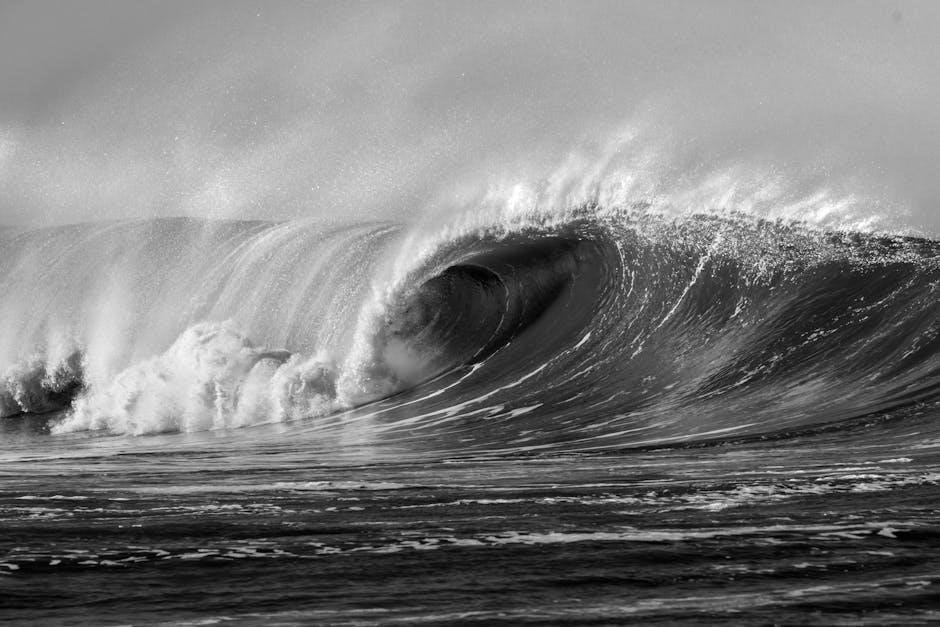Canon EOS 7D Mark II Manual: Overview
The Canon EOS 7D Mark II manual offers a comprehensive guide to the camera’s features, including its 20.2MP CMOS sensor, 10fps continuous shooting, and 65-point AF system. With dual DIGIC 6 processors, it ensures high-speed performance and excellent image quality. The magnesium alloy body provides durability, making it ideal for professional photographers and enthusiasts seeking advanced functionality.
The Canon EOS 7D Mark II is a high-performance DSLR camera designed for professional photographers and enthusiasts. Featuring a 20.2MP APS-C CMOS sensor and dual DIGIC 6 processors, it delivers exceptional image quality and fast operation. With a robust magnesium alloy body, it is built to withstand demanding conditions. The camera offers advanced features such as 10.0 fps continuous shooting, a 65-point all cross-type AF system, and Dual Pixel CMOS AF for smooth focusing in Live View and video modes. Its ISO range of 100-16000 ensures versatility in various lighting conditions. The EOS 7D Mark II also includes a built-in GPS, 3-inch LCD screen, and Full HD video capabilities. This manual provides detailed guidance to help users maximize the camera’s potential, covering everything from basic operation to advanced settings and troubleshooting.
Key Features of the Canon EOS 7D Mark II
The Canon EOS 7D Mark II boasts a 20.2MP APS-C CMOS sensor and dual DIGIC 6 processors, enabling high-speed performance and exceptional image quality. It features a 65-point all cross-type AF system for precise subject tracking and a continuous shooting rate of up to 10.0 fps. The camera’s ISO range extends from 100 to 16000, ensuring versatility in various lighting conditions. Dual Pixel CMOS AF provides smooth and accurate focusing in Live View and video modes. The magnesium alloy body offers durability, while the built-in GPS and digital compass add functionality for location-based photography. A 3-inch high-resolution LCD screen and Full HD 1080p video recording at 60 fps further enhance its capabilities. The EOS 7D Mark II also supports uncompressed HDMI output for external recording, making it a robust tool for both stills and video enthusiasts.
Importance of Reading the Manual
Reading the Canon EOS 7D Mark II manual is essential to unlock the camera’s full potential. It provides detailed instructions on operating advanced features, troubleshooting common issues, and customizing settings for optimal performance. The manual serves as a comprehensive guide, helping users understand the camera’s complex functionalities, such as the 65-point AF system, dual DIGIC 6 processors, and Full HD video recording. By understanding these features, photographers can enhance their creativity and productivity. Additionally, the manual offers insights into maintenance and firmware updates, ensuring the camera remains in top condition. Whether you’re a professional or an enthusiast, the manual is a vital resource to maximize your investment and improve your photography skills.

Downloading the Canon EOS 7D Mark II Manual
The Canon EOS 7D Mark II manual is available for download as a PDF from Canon’s official website, ensuring easy access to detailed instructions and guides.
How to Download the PDF Manual
To download the Canon EOS 7D Mark II manual, visit the official Canon website and navigate to the support section. Select your camera model from the product list, then choose the desired language. Click on the provided PDF link to initiate the download. Once the download is complete, save the file to your device. Ensure you have Adobe Acrobat Reader installed to view the PDF. The manual includes detailed instructions for camera operation, settings, and troubleshooting. Follow these steps to access the comprehensive guide and make the most of your Canon EOS 7D Mark II.

System Requirements for Viewing the PDF
To view the Canon EOS 7D Mark II manual in PDF format, ensure your device meets the necessary system requirements. Install Adobe Acrobat Reader version 6.0 or later for optimal compatibility. A high-resolution display is recommended to clearly view detailed images and diagrams. For mobile devices, ensure your PDF viewer supports zoom and navigation features. A stable internet connection is required for downloading the manual from Canon’s official website. Ensure sufficient storage space on your device to save the file, which may be large due to its comprehensive content. By meeting these requirements, you can access and navigate the manual effortlessly, making it easier to understand and utilize your camera’s features effectively.
Direct Links to the Manual
Access the Canon EOS 7D Mark II manual through direct links provided on Canon’s official website and trusted sources like Amazon and Adorama. The manual is available as a PDF file, ensuring easy download and viewing. Links are categorized into the Basic Instruction Manual, Quick Reference Guide, and detailed User Guide. These resources cover setup, advanced features, and troubleshooting. Ensure you download from reputable sites to avoid unauthorized content. The manual is also available in multiple languages, including English, Spanish, Italian, and more. Visit Canon’s support page or authorized retailers for secure and direct access to the EOS 7D Mark II manual, ensuring you have all the information needed to maximize your camera’s potential.
Available Languages for the Manual
The Canon EOS 7D Mark II manual is available in multiple languages, ensuring accessibility for users worldwide. English, Spanish, Italian, Portuguese, Arabic, and Korean versions are provided. Additional translations, including Russian and Chinese, are also accessible. This multilingual support allows users to understand and utilize the camera’s features effectively, regardless of their native language. Canon regularly updates these manuals to accommodate user requests. Visit the official Canon website or trusted sources to download the manual in your preferred language, ensuring a seamless understanding of the camera’s functionalities and settings;

Basic Operation Guide
The Basic Operation Guide provides step-by-step instructions for initial setup, including unpacking, charging, lens mounting, and inserting memory cards. It covers basic shooting modes and settings.
Quick Start Guide
The Quick Start Guide provides essential steps to begin using the Canon EOS 7D Mark II immediately. It covers unpacking, charging the battery, mounting the lens, and inserting memory cards. The guide explains basic camera controls, such as the mode dial, AF-ON button, and LCD screen navigation. It also outlines how to set the date, time, and language. Initial shooting modes like Auto and Manual are introduced, along with basic playback functions. The guide ensures users can start capturing photos and videos quickly, with clear instructions for first-time setup and operation. Refer to the guide for a seamless initial experience with the camera.
Basic Camera Controls
The Canon EOS 7D Mark II features intuitive controls designed for quick access to essential functions. The mode dial on the top-left allows selection of shooting modes, such as Manual, Aperture Priority, and Auto. The AF-ON button enables autofocus without using the shutter button, ideal for back-button focusing. The ISO button on the top-right adjusts sensitivity, while the adjacent White Balance button fine-tunes color settings. The multi-controller on the rear offers precise AF point selection and menu navigation. The Quick Control Dial simplifies adjustments for settings like aperture and shutter speed. These controls are ergonomically placed for efficient operation, ensuring photographers can make swift adjustments while maintaining focus on their subject. Understanding these controls is crucial for maximizing the camera’s potential in various shooting scenarios.
Setting Up the Camera
Setting up the Canon EOS 7D Mark II involves several key steps to ensure optimal performance. Begin by configuring the date, time, and language settings, which are essential for organizing images and maintaining accurate metadata. Next, clean the sensor using the built-in cleaning mode or manually with recommended tools. Familiarize yourself with the camera’s customization options, such as setting file formats (JPEG or RAW) and selecting autofocus modes. The manual also guides users through formatting memory cards and updating firmware to the latest version. Additionally, the Quick Start Guide provides a streamlined approach to initial setup, helping users get started quickly. Proper setup ensures the camera is tailored to individual preferences, enhancing the overall shooting experience.
Understanding the Camera’s Layout
Understanding the Canon EOS 7D Mark II’s layout is crucial for efficient operation. The camera features a mode dial on the top left for selecting shooting modes, while the AF-ON button and ISO button are conveniently located for quick access; The rear panel includes a 3-inch LCD screen for reviewing images and navigating menus. The ergonomic design places controls like the shutter button and multi-controller within easy reach. Familiarizing yourself with the external controls ensures quick adjustments during shooting. The magnesium alloy body is durable and weather-sealed, while the built-in GPS adds functionality for location tagging. Dual card slots on the side allow for versatile storage options. The intuitive layout is designed to streamline workflow, making it easy to access key functions without distractions.

Advanced Features
The Canon EOS 7D Mark II offers advanced features like Custom Settings, Menu Functions, and a sophisticated 65-point AF system for precise control and enhanced creativity.
Custom Settings
The Canon EOS 7D Mark II allows users to tailor camera settings to their preferences through Custom Settings. This feature enables photographers to adjust functions like AF tracking sensitivity, metering modes, and custom white balance presets. By saving these settings, photographers can quickly access their preferred configurations, streamlining their workflow. Additionally, custom settings can be stored and recalled via the camera’s menu, ensuring consistent results across different shooting scenarios; This level of customization enhances flexibility, making the 7D Mark II adaptable to various photography styles and conditions, whether for sports, wildlife, or studio work. The manual provides detailed guidance on configuring these settings for optimal performance.

Menu Functions
The Canon EOS 7D Mark II manual details the extensive menu functions designed to enhance customization and control. The Shooting menu offers options like image quality, white balance, and Picture Styles, while the AF menu provides advanced autofocus settings, including AF point selection and tracking sensitivity. Playback menu allows users to manage and edit images, such as rotating, protecting, or rating photos. The Setup menu covers camera maintenance, including firmware updates, sensor cleaning, and customization of camera buttons. Additionally, the My Menu feature lets users save up to six frequently used settings for quick access. These menu functions empower photographers to tailor the camera to their workflow, ensuring efficiency and precision in various shooting situations.
Advanced Shooting Modes
The Canon EOS 7D Mark II manual highlights several advanced shooting modes to cater to professional and creative needs. The Manual (M) mode offers full control over aperture, shutter speed, and ISO, ideal for precise adjustments. Aperture Priority (Av) and Shutter Priority (Tv) modes allow photographers to prioritize either aperture or shutter speed, with the camera adjusting the other parameter automatically. The Program (P) mode provides automated settings while still allowing for customization. Additionally, the camera features Custom Shooting Modes (C1, C2, C3), enabling users to save personalized settings for quick access. These modes, combined with the camera’s Dual Pixel CMOS AF, ensure versatile and precise control for capturing high-quality images in various conditions.
Focus System and AF Settings
The Canon EOS 7D Mark II manual details its advanced focus system, featuring a 65-point all cross-type AF system for high accuracy and tracking. The AF points are spread across the frame, allowing precise subject acquisition. Users can select from various AF modes, including Single Shot AF, AI Focus AF, and AI Servo AF, each tailored for different shooting scenarios. The camera also supports Custom AF Functions, enabling photographers to adjust tracking sensitivity and acceleration/deceleration tracking. Additionally, the Dual Pixel CMOS AF technology enhances live view and video focusing, providing smooth and continuous autofocus. These features make the 7D Mark II highly capable for capturing sharp images in both stills and video modes, ensuring optimal performance in dynamic environments.

Video Recording
The Canon EOS 7D Mark II supports Full HD video recording at 1920×1080 resolution, with frame rates up to 60fps, delivering smooth motion and high-quality footage. It also features uncompressed video output via HDMI for external recording, enhancing post-production capabilities. Additionally, the camera offers continuous autofocus in Live View mode, ensuring sharp focus during video capture. These features make it an excellent choice for videographers seeking professional-grade performance and flexibility in their workflows.
Full HD Video Capabilities
The Canon EOS 7D Mark II offers exceptional Full HD video recording at 1920×1080 resolution, with frame rates up to 60fps. This ensures smooth motion and detailed footage, ideal for capturing dynamic scenes. The camera supports both ALL-I and IPB compression formats, allowing for high-quality video with manageable file sizes. Additionally, the EOS 7D Mark II features Dual Pixel CMOS AF, enabling smooth and precise autofocus during video recording. The camera also includes a 3.5mm external microphone jack for high-quality audio capture. With its robust video capabilities, the EOS 7D Mark II is a versatile tool for videographers and photographers alike, delivering professional-grade video performance in a durable and compact body.
Uncompressed Video Output
The Canon EOS 7D Mark II supports uncompressed video output via its HDMI port, allowing users to capture high-quality footage without compression artifacts. This feature is ideal for professional videographers who require maximum image detail for post-production workflows. The uncompressed output can be directed to external recorders, ensuring pristine video quality. To enable this feature, navigate to the camera’s menu, select the HDMI output settings, and choose the uncompressed option. Note that an external recorder or device capable of handling uncompressed video is required. This capability enhances the camera’s versatility for advanced video production, making it a powerful tool for capturing cinematic-grade footage with precise control over image quality and editing flexibility.
Continuous Autofocus in Live View
The Canon EOS 7D Mark II features advanced Continuous Autofocus in Live View, enabling smooth and precise subject tracking during video recording and still photography. Utilizing the Dual Pixel CMOS AF system, the camera delivers fast and accurate focus acquisition, even when subjects are in motion. This functionality is particularly beneficial for capturing sharp images and videos in dynamic scenarios. To activate Continuous Autofocus in Live View, navigate to the camera’s menu, select the AF settings, and enable the continuous mode. The system ensures seamless focus transitions, making it ideal for tracking moving subjects with ease. This feature enhances the overall shooting experience, providing professionals and enthusiasts with reliable autofocus performance in various lighting conditions.

Connectivity and Accessories
The Canon EOS 7D Mark II offers enhanced connectivity, including built-in GPS and HDMI output for uncompressed video. It supports a wide range of EF lenses and accessories, ensuring versatility and professional-grade functionality for photographers and videographers alike.
Built-in GPS and Digital Compass
The Canon EOS 7D Mark II features a built-in GPS module, enabling geotagging of images and videos. This function allows photographers to record precise location data, which is particularly useful for outdoor and travel photography. The digital compass further enhances location-based information by providing direction and orientation details. Users can view the GPS data in the camera’s playback mode or through compatible software. This feature is especially beneficial for professionals who need to track shooting locations and manage their work efficiently. The GPS also supports time synchronization, ensuring accurate timestamps for images. The integration of these technologies makes the EOS 7D Mark II a versatile tool for documenting and organizing photographic projects.
HDMI Output for External Recorders
The Canon EOS 7D Mark II supports HDMI output, allowing users to connect the camera to external recorders or monitors. This feature is particularly useful for videographers, as it enables the capture of uncompressed Full HD video at 60fps. The HDMI output provides a clean signal without camera overlays, making it ideal for professional-grade video production. During HDMI output, the camera’s LCD screen remains active, allowing for simultaneous monitoring. The EOS 7D Mark II also supports timecode embedding, ensuring precise synchronization with external devices. This functionality enhances the camera’s versatility for both stills and video workflows, catering to the needs of content creators and filmmakers seeking high-quality output solutions.
Compatible Lenses and Accessories
The Canon EOS 7D Mark II is compatible with a wide range of EF and EF-S lenses, offering versatility for various photography needs. The camera’s EF mount supports over 70 different lenses, including telephoto, wide-angle, and macro options. Additionally, the EOS 7D Mark II can be paired with compatible external flashes, such as the Speedlite 600EX-RT, for enhanced lighting control. Other accessories include remote controllers like the RC-6 for wireless camera operation and battery grips for extended shooting sessions. The camera also supports GPS devices for geotagging images and wireless transmitters for seamless file transfer. These compatible lenses and accessories enhance the camera’s functionality, ensuring photographers can achieve their creative vision effectively.

Maintenance and Troubleshooting
Regularly clean the sensor and lens to prevent dust. Update firmware for optimal performance. Refer to the manual for troubleshooting common issues like error messages or connectivity problems.
Caring for Your Camera
Regular maintenance ensures optimal performance and longevity of your Canon EOS 7D Mark II. Clean the camera sensor and lens regularly to prevent dust buildup, using a soft, dry cloth and gentle cleaning solutions. Avoid harsh chemicals or abrasive materials that may damage the surfaces. Store the camera in a cool, dry place to prevent moisture and mold. Use a protective case or bag when not in use to shield against scratches and impacts. Refer to the manual for detailed cleaning methods and recommendations. Proper care extends the camera’s lifespan and maintains its precision and image quality.
Additionally, ensure all accessories, such as lenses and memory cards, are handled with care to avoid damage. Regularly update firmware to maintain functionality and performance.
Common Issues and Solutions
Users of the Canon EOS 7D Mark II may encounter issues such as blurry images, camera not turning on, or memory card errors. For blurry images, check autofocus settings and ensure proper shutter speed. If the camera won’t power on, verify battery charge and ensure contacts are clean. For memory card errors, format the card in the camera or replace it if damaged. Connectivity issues with Wi-Fi or HDMI can often be resolved by restarting the device or updating firmware. Refer to the manual for troubleshooting guides and solutions to optimize performance and resolve common problems effectively.
Firmware Updates
Regular firmware updates for the Canon EOS 7D Mark II are essential to enhance camera performance, fix bugs, and add new features. To update, connect the camera to a computer via USB or use a memory card. Visit Canon’s official website, download the latest firmware version, and follow the installation instructions carefully. Ensure the camera’s battery is fully charged and avoid interrupting the update process to prevent damage. Updated firmware improves autofocus accuracy, adds compatibility with new lenses, and enhances video recording capabilities. Always verify the firmware version on Canon’s site and install it to keep your camera optimized and functioning at its best.

Additional Resources
Explore Canon’s official website for online support, drivers, and firmware updates. Join the Canon EOS 7D Mark II community for tips and troubleshooting. Utilize recommended software like Digital Photo Professional for enhanced image editing and management.
Online Support and Drivers
Canon offers extensive online support for the EOS 7D Mark II, including downloadable drivers, firmware updates, and software tools. Visit the official Canon website to access these resources, ensuring your camera operates at its best. The site provides detailed troubleshooting guides, FAQs, and user manuals to address common issues. Additionally, Canon’s support page includes links to Digital Photo Professional and other software for enhanced image editing. For further assistance, Canon’s customer support team is available to help resolve technical queries. Regularly updating firmware and drivers is crucial for maintaining optimal performance and unlocking new features. Explore Canon’s online resources to maximize your camera’s potential and stay up-to-date with the latest advancements.
Canon EOS 7D Mark II Community
The Canon EOS 7D Mark II community is vibrant and active, offering photographers a platform to share experiences, tips, and stunning imagery. Online forums, social media groups, and specialized websites provide spaces for enthusiasts to discuss techniques, ask questions, and learn from experts. Many users share their manual settings, customizations, and workflows, fostering creativity and collaboration. The community also hosts challenges and contests, encouraging photographers to push their limits. Additionally, Canon hosts webinars and workshops, often featuring the EOS 7D Mark II, to help users master its advanced features. Being part of this community allows photographers to stay updated on the latest trends, receive feedback, and connect with like-minded individuals worldwide.
Recommended Software
For optimal performance with the Canon EOS 7D Mark II, several software tools are recommended. Canon’s Digital Photo Professional (DPP) is ideal for processing RAW images, offering advanced editing and batch processing. Adobe Photoshop and Lightroom are popular choices for professional-grade editing and cataloging. The Canon EOS Utility enables camera control, image transfer, and firmware updates. Additionally, third-party apps like GIMP and Skylum Luminar provide versatile editing options. These tools enhance workflow efficiency and help photographers achieve the best results from their EOS 7D Mark II. They are compatible with both Windows and macOS, ensuring seamless integration into any post-processing routine.




Leave a Reply
You must be logged in to post a comment.